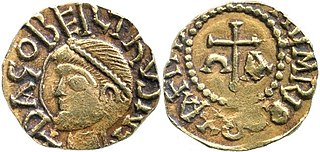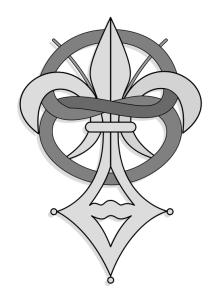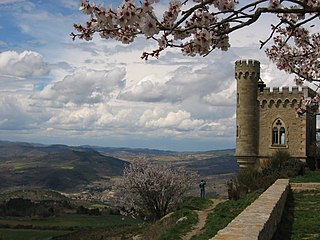Related Research Articles

Austrasia was a territory which formed the north-eastern section of the Kingdom of the Franks from the 6th to 8th centuries, ruled by the Frankish Merovingian and Carolingian dynasties during the Early Middle Ages. It was centred on the Meuse, Middle Rhine, and the Moselle rivers, and was the original territory of the Franks, including both the so-called Salian Franks and Ripuarian Franks, which Clovis I, King of the Franks (481–511) conquered after first taking control of the bordering part of Roman Gaul, which is sometimes described in this period as Neustria.

Dagobert I was King of the Franks. He ruled Austrasia (623–634) and Neustria and Burgundy (629–639). He has been described as the last king of the Merovingian dynasty to wield real royal power. Dagobert was the first Frankish king to be buried in the royal tombs at the Basilica of Saint-Denis.

The Carolingian dynasty was a Frankish noble family named after Charles Martel and his grandson Charlemagne, descendants of the Arnulfing and Pippinid clans of the 7th century AD. The dynasty consolidated its power in the 8th century, eventually making the offices of mayor of the palace and dux et princeps Francorum hereditary, and becoming the de facto rulers of the Franks as the real powers behind the Merovingian throne. In 751 the Merovingian dynasty which had ruled the Franks was overthrown with the consent of the Papacy and the aristocracy, and Pepin the Short, son of Martel, was crowned King of the Franks. The Carolingian dynasty reached its peak in 800 with the crowning of Charlemagne as the first Emperor of the Romans in the West in over three centuries. Nearly every monarch of France from Charlemagne's son Louis the Pious till the penultimate monarch of France Louis Philippe have been his descendants. His death in 814 began an extended period of fragmentation of the Carolingian Empire and decline that would eventually lead to the evolution of the Kingdom of France and the Holy Roman Empire.

The Kingdom of the Franks, also known as the Frankish Kingdom, the Frankish Empire or Francia, was the largest post-Roman barbarian kingdom in Western Europe. It was ruled by the Frankish Merovingian and Carolingian dynasties during the Early Middle Ages. Francia was among the last surviving Germanic kingdoms from the Migration Period era.

Dagobert II was a Merovingian king of the Franks, ruling in Austrasia from 675 or 676 until his death. He is one of the more obscure Merovingians. He has been considered a martyr since at least the ninth century.

Venantius Honorius Clementianus Fortunatus, known as Saint Venantius Fortunatus, was a Latin poet and hymnographer in the Merovingian Court, and a bishop of the Early Church who has been venerated since the Middle Ages.
Pierre Plantard de Saint-Clair was a French technical artist, best known for being the principal fabricator of the Priory of Sion hoax, by which he claimed from the 1960s onwards that he was a male-line Merovingian descendant of Dagobert II and the "Great Monarch" prophesied by Nostradamus. Today in France, he is commonly regarded as a con artist.

Sigebert III was the Merovingian king of Austrasia from 633 to his death around 656. He was described as the first Merovingian roi fainéant —do-nothing king—, in effect the mayor of the palace ruling the kingdom throughout his reign. However he lived a pious Christian life and was later sanctified, being remembered as Saint Sigebert of Austrasia in the Roman Catholic Church and Eastern Orthodox Church.
Philippe Louis Henri Marie de Chérisey, 9th marquess de Chérisey was a French writer, radio humorist, surrealist and supporting actor.
Géraud-Marie de Sède, baron de Liéoux was a French author, writing under the nom-de-plume of Gérard de Sède, and a member of various surrealist organizations. He was born into an aristocratic family from Comminges, the son of Marcel Alfred Gustave de Sède, baron de Liéoux and Aimée de Sède de Liéoux 's first cousins, once removed. De Sède's father was the senior editor of the Catholic newspaper Le Courrier du Pas-de-Calais owned by the De Sède family.
The Dossiers Secrets d'Henri Lobineau, supposedly compiled by Philippe Toscan du Plantier, is a 27-page document which was deposited in the Bibliothèque nationale de France on 27 April 1967. The document purports to represent a part of the history of the Priory of Sion, and is widely considered to be a forgery created by Pierre Plantard and Philippe de Chérisey. Thirteen of the 27 pages of the document are taken from another document attributed to "Henri Lobineau" dating from 1964, also thought to have been authored by Plantard, called Généalogie des Rois Mérovingiens. This document contains genealogy diagrams which apparently show Plantard to be a descendant of the Merovingian king Dagobert II.
Saint Adela and her sister Irmina of Oeren were possibly two princesses who may have been the daughters of Saint Dagobert II and his Anglo-Saxon wife, but this has largely been disproved. Some have also said Adela was the daughter of Irmina of Oeren.

Yolande was Duchess of Lorraine (1473) and Bar (1480). She was the daughter of Isabella, Duchess of Lorraine, and René of Anjou. Though she was nominally in control of major territories, she ceded her power and titles to her husband and her son. In addition, her younger sister was Margaret of Anjou, Queen of England.

The Prieuré de Sion, translated as Priory of Sion, was a fraternal organisation founded and dissolved in France in 1956 by Pierre Plantard in his failed attempt to create a prestigious neo-chivalric order. In the 1960s, Plantard began claiming that his self-styled order was the latest front for a secret society founded by crusading knight Godfrey of Bouillon, on Mount Zion in the Kingdom of Jerusalem in 1099, under the guise of the historical monastic order of the Abbey of Our Lady of Mount Zion. As a framework for his grandiose assertion of being both the Great Monarch prophesied by Nostradamus and a Merovingian pretender, Plantard further claimed the Priory of Sion was engaged in a centuries-long benevolent conspiracy to install a secret bloodline of the Merovingian dynasty on the thrones of France and the rest of Europe. To Plantard's surprise, all of his claims were fused with the notion of a Jesus bloodline and popularised by the authors of the 1982 speculative nonfiction book The Holy Blood and the Holy Grail, whose conclusions would later be borrowed by Dan Brown for his 2003 mystery thriller novel The Da Vinci Code.
Henry Soskin, better known as Henry Lincoln, was a British author, television presenter, scriptwriter, and actor. He co-wrote three Doctor Who multi-part serials in the 1960s, and — starting in the 1970s — inspired three Chronicle BBC Two documentaries on the alleged mysteries surrounding the French village of Rennes-le-Château — and, from the 1980s, co-authored and authored a series of books of which The Holy Blood and the Holy Grail was the most popular, becoming the inspiration for Dan Brown's 2003 best-selling novel, The Da Vinci Code. He was the last living person to have written for Doctor Who in the 1960s.

The Holy Blood and the Holy Grail is a book by Michael Baigent, Richard Leigh, and Henry Lincoln.

Rennes-le-Château is a commune approximately 5 km south of Couiza, in the Aude department in the Occitanie region in Southern France.
The Vita Dagoberti is an anonymous Latin biography of Dagobert III, king of the Franks (711–716). It is unreliable as a historical source. Confusing Dagobert III and the assassinated Dagobert II, the author mistakenly treats Dagobert III as a Christian martyr. The Vita is thus a saint's life, although its subject was not a saint.
Père Émile-Henri-Guillaume Hoffet belonged to the Missionary Oblates of Mary Immaculate, who became famous during the 1960s when he became implicated in the subject matters of Rennes-le-Château and the Priory of Sion.
References
- ↑ Baigent, Michael; Leigh, Richard; Lincoln, Henry (1982). The Holy Blood and the Holy Grail . Corgi. ISBN 0-552-12138-X.
- ↑ Jean-Luc Chaumeil, The Priory of Sion - Shedding Light on the Treasure and Legacy of Rennes-le-Château and the Priory of Sion (Avalonia, 2010).
- 1 2 Pierre Plantard. "Vaincre – Reprend le titre d'un périodique paru en 1942-1943, Number 1, April 1990" (PDF). jhaldezos.free.fr. Archived from the original (PDF) on 2011-08-18. Retrieved 2011-08-18.
We would like to repeat that in no case have we found any trace of the son of Dagobert II in the list of the Visigothic Razes. This Sigibert IV found refuge with his abbess sister at Oeren and was the cousin of Sigebert de Rhedae, who was alive more or less around the same time. Historians conflate these two Sigiberts into one person. When did Sigebert IV die? We don't know. Some think that he was the founder of the Habsburg family. [...] If anyone can claim to be a descendant of Sigisbert IV in the direct line it can only be Otto von Habsburg, and he alone. To all those people who write to me I have given this same reply.
- ↑ Jean-Luc Chaumeil, Le trésor du Triangle d'Or, page 163 (Nice: Alain Lefeuvre, 1979).
- ↑ Utho Argentinensis, Vita Sancti Arbogasti episcopi argentinensis in Germania prima (Apud Bolland., Junii tom. V, p. 170). This version of the text does not refer to Mathildis.
- ↑ Christian Settipani, in La Prehistoire des Capetiens (1993) argued that the Vita Sancti Arbogasti is too late a source to be accepted without care, and points to evidence that it places Arbogast and his successor Florentius up to a century too late (Arbogast died in around 600). He argues that the trio of Dagobert II, and his alleged wife Mathildis and son Sigebert, may actually have arisen from confusion with Dagobert I, his wife Nanthilde and son Sigebert (his mother was actually Ragnetrude).